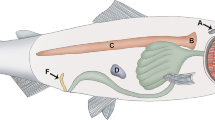Summary
Employing electron-microscopic methods that help retain polyanionic materials, we describe the extracellular coverings of a sea urchin (Lytechinus variegatus) throughout ontogeny. The surface of the embryo is covered by a two-layered cuticle (commonly called the hyaline layer), which in turn is covered by a granular layer. The granular layer is retained after addition of alcian blue to the fixative solutions, and has not been previously described for any sea urchin. After hatching, the granular layer disappears, but the hyaline layer continues to cover most of the larval surface until settlement and metamorphosis. A few days before metamorphosis, the hyaline layer lining the vestibular invagination of the competent pluteus larva is replaced by a three-layered cuticle resembling that of the adult sea urchin. The hyaline layer covering the rest of the larva is evidently lost at metamorphosis during the involution of the general epidermis.
Similar content being viewed by others
References
Afzelius B (1956) The ultrastructure of the cortical granules in the sea urchin egg as studied with the electron microscope. Exp Cell Res 10:257–285
Behnke O, Zelander T (1970) Preservation of intercellular substances by the cationic dye alcian blue in preparative procedures for electron microscopy. J Ultrastruct Res 31:414–438
Bryan J (1970) On the reconstruction of the crystalline components of the sea urchin fertilization membrane. J Cell Biol 45:606–614
Cameron RA, Hinegardner RT (1974) The initiation of metamorphosis in laboratory-cultured sea urchins. Biol Bull 146:335–342
Cameron RA, Holland ND (1983) Electron microscopy of extracellular materials during the development of a sea star, Patiria miniata (Echinodermata: Asteroidea). Cell Tissue Res 234:193–200
Chambers EL, Hinkley RE (1979) Non-propagated cortical reactions induced by the divalent ionophore A23187 in eggs of the sea urchin, Lytechinus variegatus. Exp Cell Res 124:441–446
Chandler DE, Heuser J (1980) The vitelline layer of the sea urchin egg and its modification during fertilization. J Cell Biol 84:618–632
Endo Y (1961) Changes in the cortical layer of sea urchin eggs at fertilization as studied with the electron microscope. 1. Clypeaster japonicus. Exp Cell Res 25:383–397
Hall HG, Vacquier VD (1982) The apical lamina of the sea urchin embryo: Major glycoproteins associated with the hyaline layer. Dev Biol 89:168–178
Hinegardner RT (1967) Echinoderms. In: Wilt F, Wessels N (eds) Methods in developmental biology. Thomas Crowell, New York, pp 139–156
Holland ND (1976) The fine structure of the embryo during the gastrula stage of Comanthus japonica (Echinodermata: Crinoidea). Tissue Cell 8:491–510
Holland ND (1979) Electron microscopic study of the cortical reaction of an ophiuroid echinoderm. Tissue Cell 11:445–455
Holland ND (1981) Electron microscopic study of development in a sea cucumber, Stichopus tremulus (Holothuroidea), from unfertilized egg through hatched blastula. Acta Zool Stockh 62:89–111
Holland ND, Nealson K (1978) The fine structure of the echinoderm cuticle and the subcuticular bacteria of echinoderms. Acta Zool Stockh 59:169–185
Hylander BL, Summers RG (1982) An ultrastructural characterization of hyalin in the sea urchin egg. Dev Biol 93:368–380
Luft JH (1971) Ruthenium red and violet. I. Chemistry, purification, methods of use for electron microscopy and mechanism for action. Anat Rec 171:347–368
Lundgren B (1973) Surface coatings of the sea urchin larva as revealed by ruthenium red. J Submicroscop Cytol 5:61–70
Wolpert L, Mercer EH (1963) An electron microscopic study of the development of the blastula of the sea urchin embryo and its radial polarity. Exp Cell Res 30:280–300
Author information
Authors and Affiliations
Rights and permissions
About this article
Cite this article
Cameron, R.A., Holland, N.D. Demonstration of the granular layer and the fate of the hyaline layer during the development of a sea urchin (Lytechinus variegatus). Cell Tissue Res. 239, 455–458 (1985). https://doi.org/10.1007/BF00218028
Accepted:
Issue Date:
DOI: https://doi.org/10.1007/BF00218028




